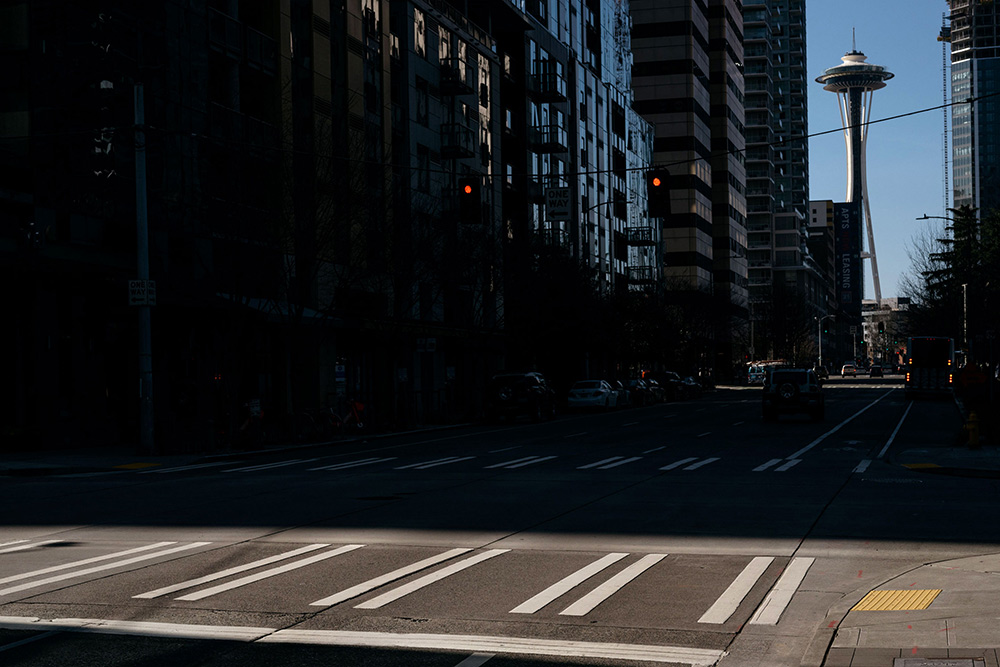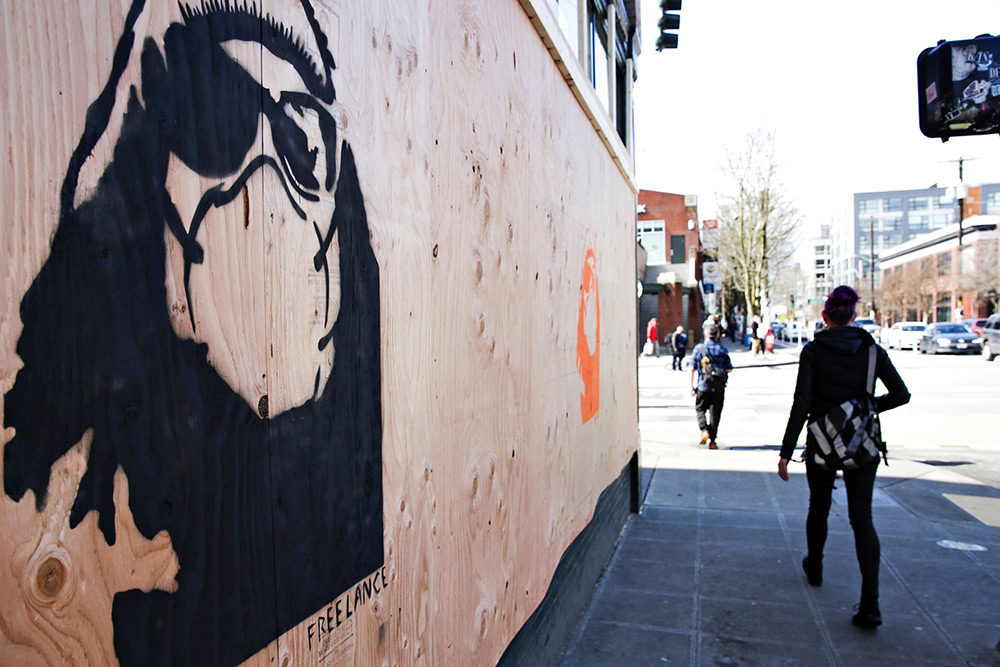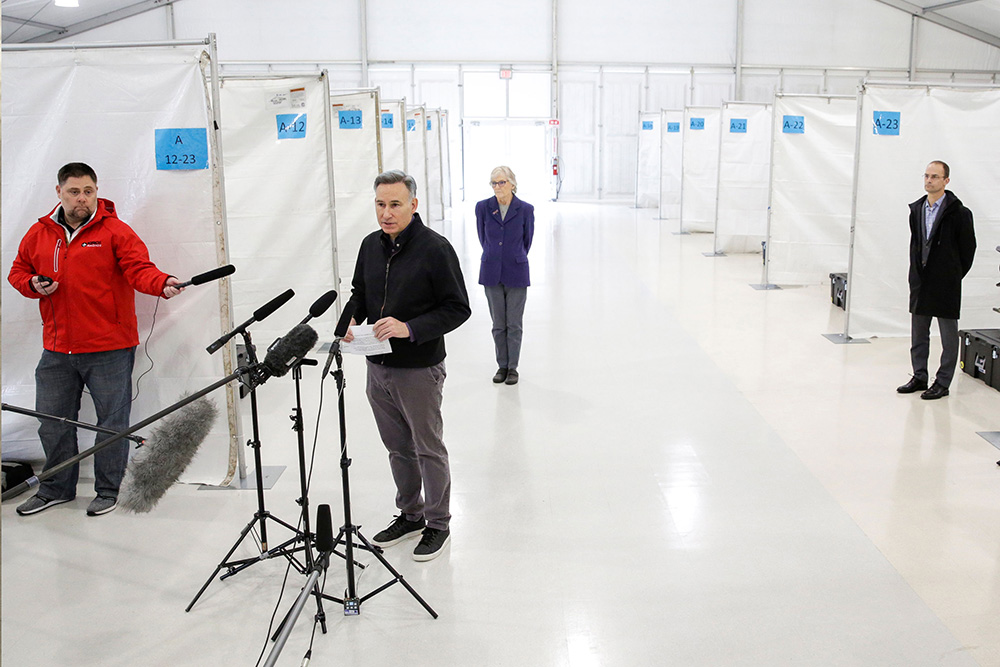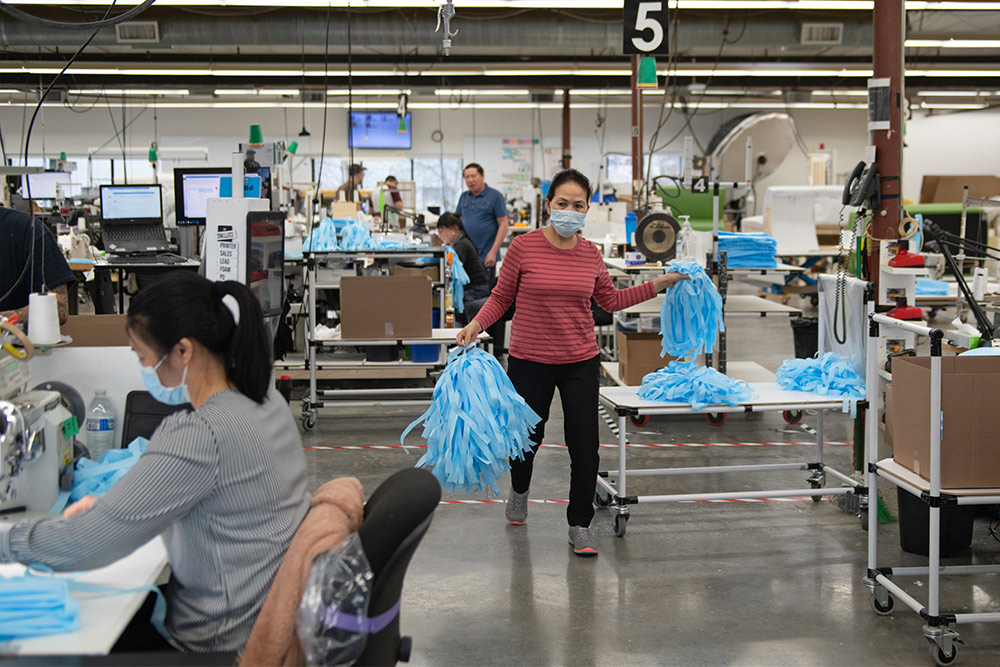湯姆·林奇并未發現世界發生變化,至少在周二上午的領導層會議上并沒有預料到。他原本想談談2021財年的預算,沒準也能趁機跟團隊加深了解。那天是2月25日,林奇剛就任福瑞德·哈金森癌癥研究中心主任一個月,當天早上他在大廳里走來走去,差點沒有找到開會的會議室。
會議議程里,林奇還為西雅圖頂尖研究機構的流行病學家特雷弗·貝德福德留了講話時間,從1月初開始,貝德福德就一直在追蹤新型冠狀病毒,也就是SARS-CoV-2。林奇稱貝德福德“非常謙遜”和“低調”,但當天早晨這位安靜的計算科學生物學家表示西雅圖的疫情狀況不妙時,立刻占據了全屋人的注意力。“人們異常安靜,側耳傾聽。”林奇說。“每個人立刻明白,他說的事將徹底改變大家的生活。”林奇在回憶當天情景時表示。“意識到嚴重性,就會印象深刻。”
對于人口350萬的大都會西雅圖來說,疫情到底能有多嚴重仍然無法完全預料。彼時,“社交疏離”尚未進入詞典。西雅圖人還在安排3月的技術論壇和春季籌款晚會;人們期待參加西雅圖風暴隊的女籃比賽、帕蒂·史密斯音樂會,還有很多人熱愛的原計劃在3月中旬舉辦的翡翠城漫畫大展,10萬名超級粉絲會前往參加。
當時在人們的認知里,新冠病毒似乎還是非常遙遠的威脅。華盛頓州只有一例確診病例,是西雅圖郊外斯諾霍米什縣的35歲男子,曾有武漢旅行史,1月中旬返美時已經感染。他接受治療,隨后康復。如果要打分,就是華盛頓1分,冠狀病毒0分。然而2月下旬的那個早晨,貝德福德口中的疫情則是迥然不同的一種情景。他表示,雖然巨大風險尚未顯現,但疫情蔓延相當嚴重。林奇明白了事情的嚴重性,第二天早晨,在福瑞德·哈金森癌癥研究中心董事會領導層的早餐會上,林奇全盤修改了議程。

“我認為今天應該集中討論新型冠狀病毒,以及西雅圖很可能要面臨的問題。”林奇對董事會主席馬特·麥克維恩說,他在西雅圖風險投資公司Madrona Venture Group擔任董事總經理。麥克維恩離開后立刻打電話給同事說:“我們要考慮一下應對策略。”
還有一人相當關注貝德福德說的數據,就是克里斯汀·格雷戈爾(綽號“克里斯”),2005年至2013年她擔任華盛頓州州長,曾任福瑞德·哈金森癌癥研究中心主席,現在擔任“西雅圖挑戰”負責人,該組織聯合了西雅圖19家規模最大的企業和機構。其中有《財富》美國500強里眾多知名企業和機構,包括亞馬遜、微軟、星巴克、開市客、波音、諾德斯特龍、阿拉斯加航空和比爾及梅琳達·蓋茨基金會等。該組織的宗旨是解決本地教育、經濟適用住房和交通方面一些棘手問題。于是,2月25日晚,西雅圖挑戰開了一次會。
西雅圖挑戰的主席蘇珊·穆拉尼在華盛頓凱撒研究院擔任總裁,該研究院在業內相當領先,下轄數十家醫療機構,全州超過70萬名會員,也越發關注所屬機構的新冠病毒防治工作。當天晚上,她花了些時間詢問格雷戈爾議程,因為她認為商界應該做些準備。
回顧起來,許多與會者都認為當時的討論是心理轉折點。開會前,他們還在酒會上輕松討論病毒;晚餐也像疫情爆發前一樣圍坐在桌旁。雖然有幾個人近得胳膊肘都挨著,還是有不少人握了手。
“我簡要介紹了預測情況會有多糟。”穆拉尼說。格雷戈爾仔細回想了貝德福德的預測。惠好公司的德文·斯托克費什、房地產估值服務提供商Zillow的里奇·巴頓,還有戶外用品公司REI的埃里克·阿茨等人都將當前疫情跟1918年大流感比較,卻沒怎么認真重視最擔心疫情的專家,即穆拉尼和最近退休的非政府衛生衛生組織PATH的首席執行官史蒂夫·戴維斯。還有一些人對美國疾病防控中心在疫情防控方面落后6到8周感到震驚。“晚餐時,所有人都感受到了危機的嚴重性。”總部位于西雅圖的全球資產管理公司Russell Investments的首席執行官米歇爾·塞茨表示。

當晚,總部位于西雅圖郊區貝爾維尤的保險業巨頭Symetra Financial的負責人瑪格麗特·梅斯特非常吃驚,她給領導團隊發了短信。“我們得打起精神。眼前是一場危機。不是小事。”她告訴同事。
“坦率地說,人們非常震驚。”格雷戈爾說。“那天大家都意識到,如果我們不想辦法控制,情勢會有多可怕。”
沒有人預料到疫情會發展如此迅速。僅僅三天后,公共衛生當局宣布華盛頓州確診第二例。該病例讓人震驚,因為感染者是一位當地少年、斯諾霍米什縣的高中生,他哪都沒去過。(他能確診僅僅因為西雅圖流感研究組織無視州政府和聯邦政府指導開展了流感監測,西雅圖流感研究總部位于西雅圖,由蓋茨風險投資公司資助,工作人員來自華盛頓大學、西雅圖兒童醫院,還有哈金森癌癥研究中心的科學家,當然也包括貝德福德。)
第二天晚上是個星期五,格雷戈爾接到電話。華盛頓州首次出現新冠病毒導致死亡,當地一家養老院爆發疫情。病毒已經在社區蔓延,迅速傳播。他們一直擔心的威脅迫在眉睫。
不過另一邊,疫情防控網絡也在迅速布下。從研究醫院和跨國企業再到全球知名機構、社區組織和政府,讓西雅圖緊密聯系的網絡正緊鑼密鼓地交流信息和計劃。格雷戈爾立即打電話給穆拉尼,讓她準備一份簡報。
如果要講述美國第一次新冠病毒爆發也就是大西雅圖地區的疫情,其實有很多方法,到本文完稿時,該地區已經有385人不幸死亡,7324人感染(在西雅圖市區所在的金縣,死亡人數294人,感染人數為4428人)。病毒影響了數十萬人的生計。但西雅圖團結一致對抗病毒的故事堪稱所有城市和組織的典范。
從某些方面來看,應對新型病毒爆發方面難找到比西雅圖條件更優越的城市。在公共衛生方面,西雅圖鮮有對手。華盛頓大學有全美領先的病毒學實驗室和規模最大的傳染病部門。有影響力的流行病學家和疾病建模專家云集,從推特上20萬粉絲的哈金森癌癥研究中心貝德福德到華盛頓大學的克里斯·默里,很多人都得到了蓋茨的資助,默里的模型還曾經被白宮借鑒。西雅圖能建立全世界第一個新冠病毒備選疫苗的試驗點,還在美國第一個使用家庭測試包進行病毒監測,其實并非偶然。
“我們有積攢了40年的基礎設施。”拉里·科里說,他從1978年就開始在華盛頓大學從事病毒學研究項目(在開發艾滋病藥物、領導哈金森癌癥研究中心和領導全球艾滋病疫苗試驗網絡方面發揮了重要作用)。“我們能滲透到社區里……能發揮影響并成為重要因素。”

西雅圖的財富同樣驚人,城市里有新興科技社區、全世界價值最高的跨國公司,還有兩位頂級富豪,其中之一就是比爾·蓋茨,他恰好也是最著名的流行病預防倡導者和資助者。西雅圖的企業除了財大氣粗,還跟遍布全球的物流、技術、生物醫藥專家聯系緊密。
此外,西雅圖的人口教育程度相當高,其中62.6%的居民擁有四年制本科學位,2019年被稱為“全美受教育程度最高的大城市”,只是相對偏向數據和科學領域。(由于西雅圖社交疏離做得相當好,稱之為“西雅圖暫停”,一些人稱贊當地人身上保留的斯堪的納維亞特質。)
通過推特上的兩個標簽就能看出城市的集體反應。#AllInSeattle是個籌款廣告,西雅圖的數十位百萬富翁在四天內向各種非營利組織捐贈了2700萬美元,而另一個流行標簽#WeGotThisSeattle如今還放在城市標志太空針塔上。
但這并不代表西雅圖已經成功脫離困境,華盛頓州州長杰伊·因斯利反復強調了這一點。但最近幾周新冠病毒在美國大規模蔓延,西雅圖的病例卻有下降趨勢,或者用流行病學家的話來說,“曲線略顯彎曲”。盡管西雅圖醫療資源有限,卻沒有像紐約和新奧爾良一樣不堪重負。在西雅圖及眾多郊區所在的金縣,確診病例每15天增加一倍;而紐約市每11.5天增加一倍,芝加哥每8.5天增加一倍。曾經運往美國新冠爆發地的物資如今都在運往新的更嚴重的地區。
也正因如此,西雅圖城市提供了一個樣本,凸顯合作的重要性。西雅圖是全球性的大城市,但很多西雅圖人,至少很多上層人士都會說:“感覺西雅圖很像個小鎮。”聯系緊密的商業社區和政府各級部門之間迅速傳遞信息、援助和解決方案。忽然之間,之前像亞馬遜和微軟一樣激烈競爭的公司不再忙著爭奪市場份額,而是站在一起努力拯救城市。
布拉德·史密斯著實沒有想到,自家后院會爆發疫情。身為微軟總裁,他肯定一直在考慮病毒相關問題,2月中旬慕尼黑一場安全會議上,白宮的團隊還在問他:微軟在中國有何發現?中國經濟低迷會產生什么連鎖反應?史密斯隨后前往羅馬參加梵蒂岡參加活動。隨著意大利北部疫情惡化,病毒成了首要考慮問題。2月28日星期五晚上,他離開意大利。
2月29日,西雅圖公共衛生部門宣布了第一例新冠病毒導致死亡病例,出現在距微軟辦公區不遠的Kirkland生命護理中心。更緊迫的是,哈金森癌癥研究中心的流行病學家特雷弗·貝德福德分享了基于病毒基因組測序數據的分析,顯示病毒已在社區秘密傳播了數周,可能已感染數百人。歷史愛好者史密斯做了兩件事:首先,他買了本關于1918年流感大流行的暢銷書,約翰·巴里寫的《大流感》(The Great Influenza),第二是打電話給朋友格雷戈爾。第二天格雷戈爾便召集西雅圖挑戰成員緊急開會。他們討論了團結私營和公共部門領導人,尤其是公共衛生專家的必要性。
第二天,格雷戈爾召開緊急會議向全體商界通報情況,后來變成了每日電話例會,有時參會者多達200人。不過格雷戈爾表示,剛開始規模小得多,只是一群領導層和金縣官員梳理情況并協調應對措施,努力“建立公眾信心”。
他們決定,可能的情況下各方力量都應該以同樣的方式做出回應,甚至亞馬遜和微軟一樣激烈競爭的對手也一樣,無論執行居家辦公政策,還是就必要員工簽協議。地方或州政府官員計劃宣布與疫情有關的政策時,公司也會事先收到通知。“大企業開始聯合行動。”格雷戈爾說。“我在公共服務事業工作多年,從沒有見過這樣的情況。”
第一次電話會議召開后沒幾天,西雅圖很多大公司都要求除了必要員工以外所有人在家辦公。微軟隨后宣布,辦公區關閉期間繼續向門衛、食堂員工等小時工支付工資。亞馬遜和Expedia等企業也紛紛效仿。
但病毒并沒有給商業界多少時間充分研究了解,已然侵入西雅圖企業界。
隨著臨近2月底,與西雅圖的多位科技領袖一樣,估值20億美元的F5 Networks的首席執行官弗朗索瓦·洛科-多諾也計劃照常工作。公司要在紐約舉辦投資者和分析師活動,然后3月中旬要在奧蘭多召開客戶年會。
但2月28日星期五晚些時候,人力資源主管把他拉到一邊。當時整個華盛頓州只有3例確診病例,但F5一名員工與其中一例與有密切接觸史。該員工的病毒測試結果幾天后才能知道,而他一直在上班,乘電梯,在新辦公大樓48層辦公。
由此引發的各種問題現在大家已經很熟悉,但在當時還都是新問題。應該關閉辦公大樓嗎?應該取消活動嗎?會不會感染?周末,F5的領導團隊在會議室里爭先恐后地咨詢專家并制定計劃。“必須迅速決定。”洛科-多諾說。后來他們關閉辦公樓徹底清潔,也或多或少迫使其他人做出決定:“我們不能再讓F5的十位高管去紐約跟投資者同處一室。”他說。

盡管如此,該決定還是引發不利影響。后來員工檢測結果為陰性,但最后一刻取消投資者見面會還是讓市場受到驚嚇,F5股價也受到重創。有幾天里,“看起來是個糟糕的決定。”洛科·多諾說。當然,當時這么做是正確的,他補充說。
幾天之內,其他科技公司也要處理類似的緊急決策。3月3日星期二,亞馬遜給員工發電子郵件稱西雅圖辦公區出現確診病例。亞馬遜在西雅圖有5萬多名員工,確診員工在總部的巴西大樓工作,最后一次去辦公室是2月25日。發病前一天晚上,該員工在附近的西雅圖辦公區吃了晚飯。
與此同時,Facebook的一位承包商也出現確診病例,最后一次去辦公室是2月21日。3月5日,微軟的雷德蒙德辦公區也出現病例,該辦公區約有5萬名員工。
“人們想知道確診病例在哪層,去過哪個辦公室。”微軟的首席人事官凱薩琳·霍根說,她通過短信得知辦公區出現確診病例。還好微軟有全球健康福利經理科倫·戴利,他擁有公共衛生領域的博士學位。每天戴利都跟美國疾控中心和世界衛生組織通電話,管理公司內部的聯系追蹤工作。
對西雅圖的科技公司來說,為員工提供快速全面的指導相對簡單,因為很多公司原本就支持新型的居家辦公模式。然而對其他一些大公司來說,得失并不容易計算。
在中國疫情爆發期間,星巴克關閉了中國80%的門店。當病毒出現在西雅圖時,星巴克已經具有相當豐富的經驗。3月6日,西雅圖市中心一家門店的員工感染,公司對商店消毒,幾天后恢復了營業。其他調整也在逐步進行,例如向受影響的員工提供14天的災難補助,還有移走店內座位。但隨著各地疫情加劇,很多員工都像費城的安妮婭·約翰遜一樣越發沮喪,因為得冒著健康風險提供咖啡。“這并不是必需的服務。”3月中旬約翰遜告訴《財富》雜志,幾天前,她突發奇想,在網上發起請愿,呼吁疫情期間星巴克關閉門店。星巴克宣布將轉為免下車自取模式時,該倡議已經吸引了37400名咖啡師和顧客的簽名。(星巴克表示,做出的決定主要根據中國的抗疫經驗,出于對員工和社區福利的擔心,也是為了支持政府遏制病毒傳播。)全美的開市客都擠滿了搶購衛生紙和罐頭的購物者,公司要求位于西雅圖東邊的總部員工正常上班。然而,開市客旅行部門一名員工死于新冠病毒,其他人在3月中旬檢測呈陽性后,不再要求員工上班。
波音最大的裝配工廠位于西雅圖北部的埃弗雷特,有大約3.5萬名員工,在普吉特灣地區雇傭了7萬名員工,疫情之初還在維持正常運轉。由于飛機裝配是波音的核心業務,即便員工出現新冠病例,生產線組裝仍然繼續。直到3月下旬,一位名叫埃爾頓·華盛頓的質檢員去世后,波音才暫停生產。
西雅圖的企業在努力尋求平衡的同時,當地醫務人員則忙于應付病人激增,還有檢測等醫療用品極度短缺。早在1月,埃弗雷特的普羅維登斯地區醫療中心就接到了全國首例新冠病毒病例,為可能發生的大流行準備相關用品。
“雖然我們早計劃中了幾步,但挑戰仍然很大。”醫療中心的首席臨床官艾米·康普頓·菲利普斯說。從1月開始,由于生產線關閉,普羅維登斯在中國的供應商已經無法滿足訂單。普羅維登斯的工作人員找之前沒有合作過的供應商,卻被報價震驚,他們發現很多人是奸商,兜售的商品也不符合醫療水平。“情況太糟糕了,我們只得去Joann商店和家得寶買了一些用品。”康普頓·菲利普斯補充說。在西雅圖一家本地電視臺的報道中,就有普羅維登斯的護士在醫院會議室自制面罩和外科口罩的畫面。
Kaas Tailored公司是西雅圖本地公司,有200名員工,主要為諾德斯特龍制造家具,也為波音生產飛機部件。3月18日,首席執行官杰夫·卡斯在聽說物資短缺的消息后,立即給普羅維登斯的一位醫生朋友發了短信:“你知道我有工廠的,對吧?”
第二天早上6點,普羅維登斯派了設計和供應小組前往卡斯在華盛頓州的馬科爾蒂奧工廠。他們做出了外科口罩的原型,第二天跟荷蘭一家公司合作后開始制作。卡斯在網上分享了相關規格,如今全球各地生產個人防護設備都可以參考。
卡斯的工廠里有員工、志愿者、妻子和四個孩子,此后一周六天,每天工作16小時。諾德斯特龍派裁縫去協助,還安排一位經理全職駐卡斯的工廠。如今,普羅維登斯的自救努力已經發展為由美國醫院協會組織的“一億口罩挑戰賽”。
總部位于西雅圖的戶外和軍用服裝制造商Outdoor Research的老板是丹·諾德斯特龍,2002年他離開家族百貨公司獨立創業。Outdoor Research轉型生產個人防護用品,被州長杰伊·伊斯利譽為堪比戰時制造業。地方機構也加大力度,填補檢測和醫療衛生領域的空白。華盛頓大學迅速組織力量,每天進行2000次測試。蓋茨資助的流感研究轉向利用亞馬遜提供的家庭咽拭子進行新冠病毒監測。
3月中旬,一位與中國有聯系的西雅圖金融家聯系了Madrona的麥克維恩,安排中國醫生與美國同行視頻通話,中方是受病毒影響的城市里的重癥和急診醫生,另一邊則是西雅圖的醫生。兩天后,在哈金森癌癥研究中心的幫助下,西雅圖時間早上6:30在Zoom上召開了信息溝通會,全美有300人參加。
剛開始,西雅圖的挑戰主要是拉動企業共同行動,但隨后轉向排除故障和支持政府。

3月初,凱撒研究院的穆拉尼問西雅圖挑戰:“有人能幫忙弄基本物資嗎?”開市客的首席執行官克雷格·杰利內克回應稱,24小時內可以中國采購4萬個N95口罩。阿拉斯加航空公司的首席執行官布拉德·蒂爾登則提出了更切實的幫助。“有一批飛機可以供你調遣。”他對穆拉尼說。
后來,華盛頓州的一位代表在電話中提到,要預付款才能確保從中國買到價值1000萬美元的防護設備,當天微軟就向政府提供了1500萬美元。
還有個例子,微軟為西雅圖采購的25萬個N95口罩被卡在聯邦快遞在孟菲斯的入境部門。3月下旬一個周六下午5點,史密斯聽說后,給白宮打了個電話找國家安全委員會的聯系人。第二天早上,口罩順利過關。
“政府對企業提出任何要求,他們都站出來說:‘能做到。’”格雷戈爾說。
西雅圖挑戰為配送醫療用品請求援助時,找來了亞馬遜和微軟的高級經理。格雷戈爾說,金縣改裝為隔離中心的汽車旅館需要配家具時,星巴克就送了過來。穆拉尼建議在疫情爆發期間西雅圖需要一位專門人員協調醫院,她的團隊在約72小時內便幫州長找到了人,最后定的是曾在沙漠風暴中建立野戰醫院的創傷外科醫生拉克爾·博諾中將。
到4月初,切實跡象表明,相關舉措協助西雅圖避免了情況變更糟。伊斯利州長把400臺西雅圖用不上的呼吸機送往東海岸。原本打算將西雅圖海鷹隊主場世紀互聯體育場改為臨時醫院的物資也運往其他州。
多數地方在評估致命病毒造成的災難性損失時,似乎只揭示出了弱點:基礎設施薄弱、供應鏈薄弱、準備不足、政府和企業的分歧。在西雅圖,疫情揭示出的仿佛是另一幅圖景:幾乎無人知曉的強大抗壓能力。史密斯說:“如果能把大家團結起來,以正確的方式協調,就可以在一起做更多事。”
事實證明,西雅圖密集的合作網絡對最初遏制危機蔓延至關重要。至于是否能有效解決新冠病毒造成的次生傷害,即經濟重創、失業率創紀錄,以及危機暴露的不平等問題,目前尚不清楚。
種種問題都是新現實,沒有簡單的答案,但只要人人團結起來,西雅圖的優勢還是很明顯。(財富中文網)
本文另一版本登載于《財富》雜志2020年5月刊,標題為《疫情中的西雅圖》。
譯者:Feb
湯姆·林奇并未發現世界發生變化,至少在周二上午的領導層會議上并沒有預料到。他原本想談談2021財年的預算,沒準也能趁機跟團隊加深了解。那天是2月25日,林奇剛就任福瑞德·哈金森癌癥研究中心主任一個月,當天早上他在大廳里走來走去,差點沒有找到開會的會議室。
會議議程里,林奇還為西雅圖頂尖研究機構的流行病學家特雷弗·貝德福德留了講話時間,從1月初開始,貝德福德就一直在追蹤新型冠狀病毒,也就是SARS-CoV-2。林奇稱貝德福德“非常謙遜”和“低調”,但當天早晨這位安靜的計算科學生物學家表示西雅圖的疫情狀況不妙時,立刻占據了全屋人的注意力。“人們異常安靜,側耳傾聽。”林奇說。“每個人立刻明白,他說的事將徹底改變大家的生活。”林奇在回憶當天情景時表示。“意識到嚴重性,就會印象深刻。”
對于人口350萬的大都會西雅圖來說,疫情到底能有多嚴重仍然無法完全預料。彼時,“社交疏離”尚未進入詞典。西雅圖人還在安排3月的技術論壇和春季籌款晚會;人們期待參加西雅圖風暴隊的女籃比賽、帕蒂·史密斯音樂會,還有很多人熱愛的原計劃在3月中旬舉辦的翡翠城漫畫大展,10萬名超級粉絲會前往參加。
當時在人們的認知里,新冠病毒似乎還是非常遙遠的威脅。華盛頓州只有一例確診病例,是西雅圖郊外斯諾霍米什縣的35歲男子,曾有武漢旅行史,1月中旬返美時已經感染。他接受治療,隨后康復。如果要打分,就是華盛頓1分,冠狀病毒0分。然而2月下旬的那個早晨,貝德福德口中的疫情則是迥然不同的一種情景。他表示,雖然巨大風險尚未顯現,但疫情蔓延相當嚴重。林奇明白了事情的嚴重性,第二天早晨,在福瑞德·哈金森癌癥研究中心董事會領導層的早餐會上,林奇全盤修改了議程。
“我認為今天應該集中討論新型冠狀病毒,以及西雅圖很可能要面臨的問題。”林奇對董事會主席馬特·麥克維恩說,他在西雅圖風險投資公司Madrona Venture Group擔任董事總經理。麥克維恩離開后立刻打電話給同事說:“我們要考慮一下應對策略。”
還有一人相當關注貝德福德說的數據,就是克里斯汀·格雷戈爾(綽號“克里斯”),2005年至2013年她擔任華盛頓州州長,曾任福瑞德·哈金森癌癥研究中心主席,現在擔任“西雅圖挑戰”負責人,該組織聯合了西雅圖19家規模最大的企業和機構。其中有《財富》美國500強里眾多知名企業和機構,包括亞馬遜、微軟、星巴克、開市客、波音、諾德斯特龍、阿拉斯加航空和比爾及梅琳達·蓋茨基金會等。該組織的宗旨是解決本地教育、經濟適用住房和交通方面一些棘手問題。于是,2月25日晚,西雅圖挑戰開了一次會。
西雅圖挑戰的主席蘇珊·穆拉尼在華盛頓凱撒研究院擔任總裁,該研究院在業內相當領先,下轄數十家醫療機構,全州超過70萬名會員,也越發關注所屬機構的新冠病毒防治工作。當天晚上,她花了些時間詢問格雷戈爾議程,因為她認為商界應該做些準備。
回顧起來,許多與會者都認為當時的討論是心理轉折點。開會前,他們還在酒會上輕松討論病毒;晚餐也像疫情爆發前一樣圍坐在桌旁。雖然有幾個人近得胳膊肘都挨著,還是有不少人握了手。
“我簡要介紹了預測情況會有多糟。”穆拉尼說。格雷戈爾仔細回想了貝德福德的預測。惠好公司的德文·斯托克費什、房地產估值服務提供商Zillow的里奇·巴頓,還有戶外用品公司REI的埃里克·阿茨等人都將當前疫情跟1918年大流感比較,卻沒怎么認真重視最擔心疫情的專家,即穆拉尼和最近退休的非政府衛生衛生組織PATH的首席執行官史蒂夫·戴維斯。還有一些人對美國疾病防控中心在疫情防控方面落后6到8周感到震驚。“晚餐時,所有人都感受到了危機的嚴重性。”總部位于西雅圖的全球資產管理公司Russell Investments的首席執行官米歇爾·塞茨表示。
當晚,總部位于西雅圖郊區貝爾維尤的保險業巨頭Symetra Financial的負責人瑪格麗特·梅斯特非常吃驚,她給領導團隊發了短信。“我們得打起精神。眼前是一場危機。不是小事。”她告訴同事。
“坦率地說,人們非常震驚。”格雷戈爾說。“那天大家都意識到,如果我們不想辦法控制,情勢會有多可怕。”
沒有人預料到疫情會發展如此迅速。僅僅三天后,公共衛生當局宣布華盛頓州確診第二例。該病例讓人震驚,因為感染者是一位當地少年、斯諾霍米什縣的高中生,他哪都沒去過。(他能確診僅僅因為西雅圖流感研究組織無視州政府和聯邦政府指導開展了流感監測,西雅圖流感研究總部位于西雅圖,由蓋茨風險投資公司資助,工作人員來自華盛頓大學、西雅圖兒童醫院,還有哈金森癌癥研究中心的科學家,當然也包括貝德福德。)
第二天晚上是個星期五,格雷戈爾接到電話。華盛頓州首次出現新冠病毒導致死亡,當地一家養老院爆發疫情。病毒已經在社區蔓延,迅速傳播。他們一直擔心的威脅迫在眉睫。
不過另一邊,疫情防控網絡也在迅速布下。從研究醫院和跨國企業再到全球知名機構、社區組織和政府,讓西雅圖緊密聯系的網絡正緊鑼密鼓地交流信息和計劃。格雷戈爾立即打電話給穆拉尼,讓她準備一份簡報。
如果要講述美國第一次新冠病毒爆發也就是大西雅圖地區的疫情,其實有很多方法,到本文完稿時,該地區已經有385人不幸死亡,7324人感染(在西雅圖市區所在的金縣,死亡人數294人,感染人數為4428人)。病毒影響了數十萬人的生計。但西雅圖團結一致對抗病毒的故事堪稱所有城市和組織的典范。
從某些方面來看,應對新型病毒爆發方面難找到比西雅圖條件更優越的城市。在公共衛生方面,西雅圖鮮有對手。華盛頓大學有全美領先的病毒學實驗室和規模最大的傳染病部門。有影響力的流行病學家和疾病建模專家云集,從推特上20萬粉絲的哈金森癌癥研究中心貝德福德到華盛頓大學的克里斯·默里,很多人都得到了蓋茨的資助,默里的模型還曾經被白宮借鑒。西雅圖能建立全世界第一個新冠病毒備選疫苗的試驗點,還在美國第一個使用家庭測試包進行病毒監測,其實并非偶然。
“我們有積攢了40年的基礎設施。”拉里·科里說,他從1978年就開始在華盛頓大學從事病毒學研究項目(在開發艾滋病藥物、領導哈金森癌癥研究中心和領導全球艾滋病疫苗試驗網絡方面發揮了重要作用)。“我們能滲透到社區里……能發揮影響并成為重要因素。”
西雅圖的財富同樣驚人,城市里有新興科技社區、全世界價值最高的跨國公司,還有兩位頂級富豪,其中之一就是比爾·蓋茨,他恰好也是最著名的流行病預防倡導者和資助者。西雅圖的企業除了財大氣粗,還跟遍布全球的物流、技術、生物醫藥專家聯系緊密。
此外,西雅圖的人口教育程度相當高,其中62.6%的居民擁有四年制本科學位,2019年被稱為“全美受教育程度最高的大城市”,只是相對偏向數據和科學領域。(由于西雅圖社交疏離做得相當好,稱之為“西雅圖暫停”,一些人稱贊當地人身上保留的斯堪的納維亞特質。)
通過推特上的兩個標簽就能看出城市的集體反應。#AllInSeattle是個籌款廣告,西雅圖的數十位百萬富翁在四天內向各種非營利組織捐贈了2700萬美元,而另一個流行標簽#WeGotThisSeattle如今還放在城市標志太空針塔上。
但這并不代表西雅圖已經成功脫離困境,華盛頓州州長杰伊·因斯利反復強調了這一點。但最近幾周新冠病毒在美國大規模蔓延,西雅圖的病例卻有下降趨勢,或者用流行病學家的話來說,“曲線略顯彎曲”。盡管西雅圖醫療資源有限,卻沒有像紐約和新奧爾良一樣不堪重負。在西雅圖及眾多郊區所在的金縣,確診病例每15天增加一倍;而紐約市每11.5天增加一倍,芝加哥每8.5天增加一倍。曾經運往美國新冠爆發地的物資如今都在運往新的更嚴重的地區。
也正因如此,西雅圖城市提供了一個樣本,凸顯合作的重要性。西雅圖是全球性的大城市,但很多西雅圖人,至少很多上層人士都會說:“感覺西雅圖很像個小鎮。”聯系緊密的商業社區和政府各級部門之間迅速傳遞信息、援助和解決方案。忽然之間,之前像亞馬遜和微軟一樣激烈競爭的公司不再忙著爭奪市場份額,而是站在一起努力拯救城市。
布拉德·史密斯著實沒有想到,自家后院會爆發疫情。身為微軟總裁,他肯定一直在考慮病毒相關問題,2月中旬慕尼黑一場安全會議上,白宮的團隊還在問他:微軟在中國有何發現?中國經濟低迷會產生什么連鎖反應?史密斯隨后前往羅馬參加梵蒂岡參加活動。隨著意大利北部疫情惡化,病毒成了首要考慮問題。2月28日星期五晚上,他離開意大利。
2月29日,西雅圖公共衛生部門宣布了第一例新冠病毒導致死亡病例,出現在距微軟辦公區不遠的Kirkland生命護理中心。更緊迫的是,哈金森癌癥研究中心的流行病學家特雷弗·貝德福德分享了基于病毒基因組測序數據的分析,顯示病毒已在社區秘密傳播了數周,可能已感染數百人。歷史愛好者史密斯做了兩件事:首先,他買了本關于1918年流感大流行的暢銷書,約翰·巴里寫的《大流感》(The Great Influenza),第二是打電話給朋友格雷戈爾。第二天格雷戈爾便召集西雅圖挑戰成員緊急開會。他們討論了團結私營和公共部門領導人,尤其是公共衛生專家的必要性。
第二天,格雷戈爾召開緊急會議向全體商界通報情況,后來變成了每日電話例會,有時參會者多達200人。不過格雷戈爾表示,剛開始規模小得多,只是一群領導層和金縣官員梳理情況并協調應對措施,努力“建立公眾信心”。
他們決定,可能的情況下各方力量都應該以同樣的方式做出回應,甚至亞馬遜和微軟一樣激烈競爭的對手也一樣,無論執行居家辦公政策,還是就必要員工簽協議。地方或州政府官員計劃宣布與疫情有關的政策時,公司也會事先收到通知。“大企業開始聯合行動。”格雷戈爾說。“我在公共服務事業工作多年,從沒有見過這樣的情況。”
第一次電話會議召開后沒幾天,西雅圖很多大公司都要求除了必要員工以外所有人在家辦公。微軟隨后宣布,辦公區關閉期間繼續向門衛、食堂員工等小時工支付工資。亞馬遜和Expedia等企業也紛紛效仿。
但病毒并沒有給商業界多少時間充分研究了解,已然侵入西雅圖企業界。
隨著臨近2月底,與西雅圖的多位科技領袖一樣,估值20億美元的F5 Networks的首席執行官弗朗索瓦·洛科-多諾也計劃照常工作。公司要在紐約舉辦投資者和分析師活動,然后3月中旬要在奧蘭多召開客戶年會。
但2月28日星期五晚些時候,人力資源主管把他拉到一邊。當時整個華盛頓州只有3例確診病例,但F5一名員工與其中一例與有密切接觸史。該員工的病毒測試結果幾天后才能知道,而他一直在上班,乘電梯,在新辦公大樓48層辦公。
由此引發的各種問題現在大家已經很熟悉,但在當時還都是新問題。應該關閉辦公大樓嗎?應該取消活動嗎?會不會感染?周末,F5的領導團隊在會議室里爭先恐后地咨詢專家并制定計劃。“必須迅速決定。”洛科-多諾說。后來他們關閉辦公樓徹底清潔,也或多或少迫使其他人做出決定:“我們不能再讓F5的十位高管去紐約跟投資者同處一室。”他說。
盡管如此,該決定還是引發不利影響。后來員工檢測結果為陰性,但最后一刻取消投資者見面會還是讓市場受到驚嚇,F5股價也受到重創。有幾天里,“看起來是個糟糕的決定。”洛科·多諾說。當然,當時這么做是正確的,他補充說。
幾天之內,其他科技公司也要處理類似的緊急決策。3月3日星期二,亞馬遜給員工發電子郵件稱西雅圖辦公區出現確診病例。亞馬遜在西雅圖有5萬多名員工,確診員工在總部的巴西大樓工作,最后一次去辦公室是2月25日。發病前一天晚上,該員工在附近的西雅圖辦公區吃了晚飯。
與此同時,Facebook的一位承包商也出現確診病例,最后一次去辦公室是2月21日。3月5日,微軟的雷德蒙德辦公區也出現病例,該辦公區約有5萬名員工。
“人們想知道確診病例在哪層,去過哪個辦公室。”微軟的首席人事官凱薩琳·霍根說,她通過短信得知辦公區出現確診病例。還好微軟有全球健康福利經理科倫·戴利,他擁有公共衛生領域的博士學位。每天戴利都跟美國疾控中心和世界衛生組織通電話,管理公司內部的聯系追蹤工作。
對西雅圖的科技公司來說,為員工提供快速全面的指導相對簡單,因為很多公司原本就支持新型的居家辦公模式。然而對其他一些大公司來說,得失并不容易計算。
在中國疫情爆發期間,星巴克關閉了中國80%的門店。當病毒出現在西雅圖時,星巴克已經具有相當豐富的經驗。3月6日,西雅圖市中心一家門店的員工感染,公司對商店消毒,幾天后恢復了營業。其他調整也在逐步進行,例如向受影響的員工提供14天的災難補助,還有移走店內座位。但隨著各地疫情加劇,很多員工都像費城的安妮婭·約翰遜一樣越發沮喪,因為得冒著健康風險提供咖啡。“這并不是必需的服務。”3月中旬約翰遜告訴《財富》雜志,幾天前,她突發奇想,在網上發起請愿,呼吁疫情期間星巴克關閉門店。星巴克宣布將轉為免下車自取模式時,該倡議已經吸引了37400名咖啡師和顧客的簽名。(星巴克表示,做出的決定主要根據中國的抗疫經驗,出于對員工和社區福利的擔心,也是為了支持政府遏制病毒傳播。)全美的開市客都擠滿了搶購衛生紙和罐頭的購物者,公司要求位于西雅圖東邊的總部員工正常上班。然而,開市客旅行部門一名員工死于新冠病毒,其他人在3月中旬檢測呈陽性后,不再要求員工上班。
波音最大的裝配工廠位于西雅圖北部的埃弗雷特,有大約3.5萬名員工,在普吉特灣地區雇傭了7萬名員工,疫情之初還在維持正常運轉。由于飛機裝配是波音的核心業務,即便員工出現新冠病例,生產線組裝仍然繼續。直到3月下旬,一位名叫埃爾頓·華盛頓的質檢員去世后,波音才暫停生產。
西雅圖的企業在努力尋求平衡的同時,當地醫務人員則忙于應付病人激增,還有檢測等醫療用品極度短缺。早在1月,埃弗雷特的普羅維登斯地區醫療中心就接到了全國首例新冠病毒病例,為可能發生的大流行準備相關用品。
“雖然我們早計劃中了幾步,但挑戰仍然很大。”醫療中心的首席臨床官艾米·康普頓·菲利普斯說。從1月開始,由于生產線關閉,普羅維登斯在中國的供應商已經無法滿足訂單。普羅維登斯的工作人員找之前沒有合作過的供應商,卻被報價震驚,他們發現很多人是奸商,兜售的商品也不符合醫療水平。“情況太糟糕了,我們只得去Joann商店和家得寶買了一些用品。”康普頓·菲利普斯補充說。在西雅圖一家本地電視臺的報道中,就有普羅維登斯的護士在醫院會議室自制面罩和外科口罩的畫面。
Kaas Tailored公司是西雅圖本地公司,有200名員工,主要為諾德斯特龍制造家具,也為波音生產飛機部件。3月18日,首席執行官杰夫·卡斯在聽說物資短缺的消息后,立即給普羅維登斯的一位醫生朋友發了短信:“你知道我有工廠的,對吧?”
第二天早上6點,普羅維登斯派了設計和供應小組前往卡斯在華盛頓州的馬科爾蒂奧工廠。他們做出了外科口罩的原型,第二天跟荷蘭一家公司合作后開始制作。卡斯在網上分享了相關規格,如今全球各地生產個人防護設備都可以參考。
卡斯的工廠里有員工、志愿者、妻子和四個孩子,此后一周六天,每天工作16小時。諾德斯特龍派裁縫去協助,還安排一位經理全職駐卡斯的工廠。如今,普羅維登斯的自救努力已經發展為由美國醫院協會組織的“一億口罩挑戰賽”。
總部位于西雅圖的戶外和軍用服裝制造商Outdoor Research的老板是丹·諾德斯特龍,2002年他離開家族百貨公司獨立創業。Outdoor Research轉型生產個人防護用品,被州長杰伊·伊斯利譽為堪比戰時制造業。地方機構也加大力度,填補檢測和醫療衛生領域的空白。華盛頓大學迅速組織力量,每天進行2000次測試。蓋茨資助的流感研究轉向利用亞馬遜提供的家庭咽拭子進行新冠病毒監測。
3月中旬,一位與中國有聯系的西雅圖金融家聯系了Madrona的麥克維恩,安排中國醫生與美國同行視頻通話,中方是受病毒影響的城市里的重癥和急診醫生,另一邊則是西雅圖的醫生。兩天后,在哈金森癌癥研究中心的幫助下,西雅圖時間早上6:30在Zoom上召開了信息溝通會,全美有300人參加。
剛開始,西雅圖的挑戰主要是拉動企業共同行動,但隨后轉向排除故障和支持政府。
3月初,凱撒研究院的穆拉尼問西雅圖挑戰:“有人能幫忙弄基本物資嗎?”開市客的首席執行官克雷格·杰利內克回應稱,24小時內可以中國采購4萬個N95口罩。阿拉斯加航空公司的首席執行官布拉德·蒂爾登則提出了更切實的幫助。“有一批飛機可以供你調遣。”他對穆拉尼說。
后來,華盛頓州的一位代表在電話中提到,要預付款才能確保從中國買到價值1000萬美元的防護設備,當天微軟就向政府提供了1500萬美元。
還有個例子,微軟為西雅圖采購的25萬個N95口罩被卡在聯邦快遞在孟菲斯的入境部門。3月下旬一個周六下午5點,史密斯聽說后,給白宮打了個電話找國家安全委員會的聯系人。第二天早上,口罩順利過關。
“政府對企業提出任何要求,他們都站出來說:‘能做到。’”格雷戈爾說。
西雅圖挑戰為配送醫療用品請求援助時,找來了亞馬遜和微軟的高級經理。格雷戈爾說,金縣改裝為隔離中心的汽車旅館需要配家具時,星巴克就送了過來。穆拉尼建議在疫情爆發期間西雅圖需要一位專門人員協調醫院,她的團隊在約72小時內便幫州長找到了人,最后定的是曾在沙漠風暴中建立野戰醫院的創傷外科醫生拉克爾·博諾中將。
到4月初,切實跡象表明,相關舉措協助西雅圖避免了情況變更糟。伊斯利州長把400臺西雅圖用不上的呼吸機送往東海岸。原本打算將西雅圖海鷹隊主場世紀互聯體育場改為臨時醫院的物資也運往其他州。
多數地方在評估致命病毒造成的災難性損失時,似乎只揭示出了弱點:基礎設施薄弱、供應鏈薄弱、準備不足、政府和企業的分歧。在西雅圖,疫情揭示出的仿佛是另一幅圖景:幾乎無人知曉的強大抗壓能力。史密斯說:“如果能把大家團結起來,以正確的方式協調,就可以在一起做更多事。”
事實證明,西雅圖密集的合作網絡對最初遏制危機蔓延至關重要。至于是否能有效解決新冠病毒造成的次生傷害,即經濟重創、失業率創紀錄,以及危機暴露的不平等問題,目前尚不清楚。
種種問題都是新現實,沒有簡單的答案,但只要人人團結起來,西雅圖的優勢還是很明顯。(財富中文網)
本文另一版本登載于《財富》雜志2020年5月刊,標題為《疫情中的西雅圖》。
譯者:Feb
Tom Lynch hadn’t expected the world to change—or at least his perception of it—at his Tuesday morning leadership meeting. He had expected to talk about the fiscal year 2021 budget and maybe to get to know his team a little better. It was Feb. 25, and Lynch was just four weeks into the job as director of the Fred Hutchinson Cancer Research Center, so new that as he walked the halls of the Hutch that morning he struggled to find the right conference room.
Lynch had also made time on the meeting’s agenda for Trevor Bedford, an epidemiologist at the prestigious Seattle-based research institute who had been tracking the novel coronavirus known as SARS-CoV-2 since early January. Lynch describes Bedford as “very humble” and “understated,” but that morning, as the quiet computational biologist laid out his grim projections for the virus’s impact on Seattle, he held the room. People became incredibly quiet and just listened,” says Lynch. “Everyone in the room at the same time got that what he was talking about was something that was going to really change our lives.” Lynch vividly recalls that day. “You remember where you were when you realized what this was.”
What this was was still a completely unfathomable proposition for most in the global metropolis of 3.5 million. “Social distancing” had not yet entered the lexicon. At the time, Seattleites were still making arrangements for March tech conferences and spring fund?raising galas; people were looking ahead to attending Seattle Storm games and Patti Smith concerts and the Emerald City Comic Con, a beloved annual gathering of 100,000 superfans slated for mid-March.
If people knew it at all, COVID-19 was a threat that seemed at least an ocean away. The State of Washington had reported just one known case, that of a 35-year-old man from Snohomish County outside Seattle, who had traveled to Wuhan and gotten sick upon his return in mid-January. He’d been treated and recovered. For those keeping score, it was Washington–1, coronavirus–0. But on that morning in late February, Bedford framed the situation quite differently; the virus was an urgent if not yet visible existential threat. Lynch got the message, and the next morning, in a breakfast meeting with Fred Hutch’s board leadership it was Lynch who upended the agenda.
“I think we should spend this entire conversation talking about COVID-19, and what’s very likely to be coming down the pike here in Seattle,” Lynch said to his chair Matt McIlwain, a managing director at Madrona Venture Group, the Seattle-based venture capital firm. McIlwain left and immediately called his VC colleagues: “We need to think through what our strategy is,” he said.
Another person looking at Bedford’s data was Christine “Chris” Gregoire, a former Washington state governor—she served from 2005 to 2013—former Fred Hutch chair, and now head of an organization called Challenge Seattle, which engages 19 of the city’s largest businesses and institutions. Those include a striking number of name-brand Fortune 500 companies and organizations,including Amazon, Microsoft, Starbucks, Costco, Boeing, Nordstrom, Alaska Air, and the Bill & Melinda Gates Foundation, among others. The group was founded to solve some of the region’s more intractable problems surrounding education, affordable housing, and transportation. As it happened, Challenge Seattle had one of its meetings on the night of Feb. 25.
Challenge Seattle chair Susan Mullaney, the president of Kaiser Permanente Washington—which has dozens of health facilities, a leading research center, and more than 700,000 members across the state—had been following, with increasing alarm, her own group’s COVID-19 modeling efforts. She asked Gregoire for some time on the agenda that night; this was something she thought the business community needed to prepare for.
Many attendees now remember the event as their psychological turning point. Earlier in the evening, they’d casually discussed the virus over wine; at dinner, they’d sat—as one did, pre-pandemic—tightly bunched around tables. Though a few were already bumping elbows, many shook hands.
“I gave a brief update on how bad we thought it would be,” says Mullaney. Gregoire went over Bedford’s projections. As the group, which included Weyerhaeuser’s Devin Stockfish, Zillow’s Rich Barton, and REI’s Eric Artz, talked through comparisons to the 1918 flu pandemic, it was lost on no one that the most concerned among the group were its subject-matter experts—Mullaney and Steve Davis, the recently retired CEO of PATH, the global health organization. Some were struck by the assessment that the CDC was six to eight weeks behind on the issue. “The severity of it was sinking into all of us during that dinner,” says Michelle Seitz, CEO of Russell Investments, the Seattle-based global asset manager.
Margaret Meister, head of Symetra Financial, an insurance giant based in Bellevue, the Seattle suburb, had been so startled she texted her leadership team that night. “We need to up our game. This is a crisis. This is not some small thing,” she told them.
“Quite candidly, there was absolute shock around the table,” says Gregoire. “That was the day that everybody saw how dire this could be if we didn’t get to work.”
What nobody imagined was how quickly things would turn. Just three days later, public health authorities announced the state’s second confirmed case of COVID-19. It was a stunning one: The infected individual was a local teenager, a high school student also from Snohomish County but who hadn’t traveled anywhere. (His case had been detected only because the Seattle Flu Study, an influenza surveillance effort funded by Seattle-based Gates Ventures and staffed by University of Washington, Seattle Children’s Hospital, and Hutch scientists—Bedford among them—ignored state and federal guidelines and tested samples.)
And then the following night, a Friday, Gregoire got a call. The state had its first COVID-19 death, and there was an outbreak at a local nursing home. The virus was in the community, and it was spreading. The threat they’d all been worrying about had already arrived.
But something else had been spreading too. The networks that knit Seattle together—running from its research hospitals and global businesses to world-eminent institutions, community organizations, and government—were thrumming with the exchange of information and intentions. Gregoire immediately called Mullaney and asked her to prepare another briefing.
****
There are many ways to tell the story of America’s first COVID-19 outbreak—an epidemic that, in the Greater Seattle area, has to date tragically killed 385 and infected 7,324 (in King County, home to Seattle proper, the numbers are 294 deaths and 4,428 infections). The virus has stolen the livelihoods of hundreds of thousands more. But the story of how Seattle came together can be a model for any city and organization.
In some ways, it’s hard to dream up a city better equipped to manage an outbreak of a new and deadly pathogen. Seattle has few worthy rivals when it comes to public health. In the University of Washington, the city has one of the nation’s leading virology labs and one of its largest infectious disease departments. It’s a town full of influential epidemiologists and disease modelers, many of whom have had their efforts blessed with Gates dollars, from the Hutch’s Bedford—with 200,000 Twitter followers—to the University of Washington’s Chris Murray, whose models are cited by the White House. It’s no accident that Seattle has the world’s first operational trial site for a COVID-19 vaccine candidate, or that it’s the first city in the country doing COVID-19 surveillance with at-home testing kits.
“We have an infrastructure that is 40 years in the making,” says Larry Corey, the man who started UW’s virology program in 1978 (and has since been instrumental in developing AIDS drugs, helmed the Hutch, and led the global HIV Vaccine Trials Network). “We’ve been able to permeate our community…we’re able to influence and be a factor.”
Seattle is also a city of staggering wealth, home to a burgeoning tech community as well as the world’s most valuable multinational companies and the world’s two richest men, one of whom, Bill Gates, just so happens to be the planet’s most prominent advocate and funder of pandemic preparedness. Beyond those deep pockets, these enterprises are well connected to expertise—logistical, technical, biomedical—that spans the globe.
It all adds up to a highly educated population—with 62.6% of its residents holding four-year degrees, it was dubbed “America’s most-educated big city” in 2019—with a bias toward data and science. (Some also credit locals’ Scandinavian reserve—which manifests as the “Seattle freeze”—for their success at social distancing.)
Two Twitter hashtags epitomize the city’s collective response. #AllInSeattle—a fundraising banner under which dozens of the city’s millionaires donated $27 million to various nonprofits in four days—and #WeGotThisSeattle, a hashtag that trended on Twitter and was stitched on a flag that now crowns the city’s iconic Space Needle.
That’s not to say the city is out of the woods—Washington State Gov. Jay Inslee has stressed this point repeatedly—but in recent weeks as COVID-19 has continued its devastating spread across the U.S., Seattle has found a bit of a clearing, or in epidemiologist-speak, some “curve bending.” Its hospitals, though constrained by resources, have not been overwhelmed like those in New York and New Orleans. In King County, where Seattle and many of its suburbs lie, ?COVID-19 cases today are doubling once every 15 days; that compares with every 11.5 days in New York City and every 8.5 days in Chicago. Supplies once destined for America’s ?COVID-19 ground zero are now being rerouted to new, hotter hot zones.
In that way, the city offers a playbook, one that points to the importance of collaboration. Seattle is a big global city, but as many Seattleites will tell you—powerful ones, at least—“it feels a lot like a small town.” Information, and aid, and solutions were being rapidly passed around Seattle’s tight-knit business community and throughout the ranks of government. Suddenly some of the most cutthroat companies on the planet, like Amazon and Microsoft, weren’t trying to fight for market share, they were on the same side for once, trying to save their city.
****
Brad Smith hadn’t expected to come home to find an outbreak in his backyard. As Microsoft’s president, he’d been thinking about the virus, certainly—he’d been at a security conference in Munich mid-February, where he’d met a team from the White House who had peppered him with questions: What had the company seen in China? What would be the ripple effect of China’s economic downturn? Smith had then gone to Rome for an event at the Vatican; as the outbreak worsened in northern Italy, the virus was top of mind. He had left Italy the night of Friday, Feb. 28.
On Feb. 29, local public health authorities announced its first COVID death, an outbreak at the Life Care Center in Kirkland—a short drive from Microsoft’s campus. Adding to the urgency, Hutch epidemiologist Trevor Bedford shared an analysis, based on genomic-sequencing data of the virus, that suggested SARS-CoV-2 had been stealthily circulating in the community for weeks, likely infecting hundreds. Smith, a history buff, did two things: He ordered the best-regarded book on the 1918 flu pandemic, John Barry’s The Great Influenza, and he phoned his friend Gregoire, who had called for an emergency meeting of Challenge Seattle members the following day. They discussed the need to gather leaders from both the private and public sectors—and particularly public health experts.
The next day Gregoire held the emergency meeting, becoming the first in what is a now an ongoing series of daily COVID-19 crisis calls, open to the entire business community, sometimes with as many as 200 participants. At the beginning though, it was a much smaller group of leaders and King County officials trying to establish the facts and coordinate a response in an effort to “build public confidence,” says Gregoire.
They decided, when possible, organizations—even fierce competitors, like Amazon and Microsoft—should respond in the same way, whether it be on work-from-home policies or protocols around essential employees. Those companies also got a heads-up whenever local or state officials were planning to announce outbreak-related policies. “So these big companies began acting in concert,” says Gregoire. “I’ve had a career in public service, and I’ve never seen anything like this.”
Within days of the group’s first call, many of the city’s largest employers had asked all but their essential workers to stay home. Microsoft went on to announce it would continue to pay its hourly workers—janitors, cafeteria staff—while the campus was closed. Others, like Amazon and Expedia, followed suit.
But the virus didn’t wait for the business community to get its bearings. It had already crossed into Seattle’s corporate sector.
****
Like many of Seattle’s tech leaders, Fran?ois Locoh-Donou, CEO of $2 billion F5 Networks, was planning for business as usual as February drew to a close. There was an investor and analyst event in New York, then the company’s annual customer meeting in Orlando mid-March.
But late on Friday, Feb. 28, his HR chief had taken him aside. There had been just three confirmed COVID cases in the whole state of Washington then, but one of them had been in close contact with an F5 employee. That employee—whose own COVID test results wouldn’t be available for a few days—had been coming to work, riding the elevator, and occupying space in the company’s new, 48-floor office tower.
That raised all sorts of questions—familiar now, but quite novel then. Should they close the office tower? Should they forgo their events? Had they themselves been exposed? Working out of a conference room that weekend, F5’s leadership team scrambled to consult experts and formulate a plan. “We had to make decisions really quickly,” says Locoh-Donou. They closed the tower for cleaning, a fact that more or less forced the other decisions: “We couldn’t send 10 executives from F5 Tower to be in a room with investors in New York City,” he says.
The decision hurt nonetheless. The employee tested negative, but the last-minute cancellation of the investor event spooked the market, and F5’s stock price took a beating. For a couple of days, “it looked like a bad decision,” says Locoh-Donou. Of course, he adds, it was the right call.
Within days the city’s other tech companies were dealing with similarly urgent decisions. Amazon emailed employees on Tuesday, March 3, about a confirmed case on its Seattle campus; the individual—one of the company’s 50,000-plus based in Seattle—worked out of the headquarters’ Brazil building and had last been in the office on Feb. 25. The night before falling ill, that employee had eaten dinner at Facebook’s nearby Seattle campus.
Facebook, meanwhile, had its own confirmed case—a contractor who had last been in the company’s local offices on Feb. 21. Microsoft reported a case on its Redmond campus, peopled by roughly 50,000 employees, on March 5.
“People wanted to know what floor they were on or what room they were in,” says Kathleen Hogan, Microsoft’s chief people officer, who got word of the confirmed case on their campus over text. Microsoft benefited from the expertise of Colleen Daly, the company’s global wellness benefits manager, who holds a Ph.D. in public health. Daly was on daily calls with the CDC and World Health Organization and managed the company’s internal contact tracing efforts.
For the city’s tech companies, many of which are in the business of enabling the burgeoning work-from-home economy, issuing swift and sweeping guidance for their employees was relatively straightforward. The calculation was not so simple for some of Seattle’s other large employers.
****
Having closed down 80% of its stores in China during the outbreak, Starbucks already had experience with COVID-19 when the virus showed up in its hometown. When a staff member in a downtown Seattle store came down with the disease on March 6, the company sanitized the store and resumed operations a few days later. The company phased in other changes—like offering 14 days of catastrophe pay to Covid-impacted workers and removing seating. But as the outbreak intensified across the U.S., employees like Aniya Johnson of Philadelphia grew frustrated that they were being asked to risk their health to serve coffee. “It’s not an essential service,” Johnson told Fortune in mid-March, days after she had, on a whim, started an online petition calling on Starbucks to close stores during the pandemic. The effort attracted 37,400 signatures from baristas and customers by the time Starbucks announced it was moving primarily to a drive-through model. (Starbucks says its decisions were informed by the China experience and grounded by concern about the well-being of its employees and communities, and its desire to support governments in efforts to mitigate the virus’s spread.) Costco—whose stores were deluged nationwide with shoppers seeking toilet paper and canned goods—asked employees at its headquarters, just east of the city, to report to work. That request was dropped after an employee in the company’s travel department died of COVID-19 and others tested positive in mid-March.
Boeing, which employs roughly 35,000 at its largest factory in Everett, just north of the city, and 70,000 in the Puget Sound region, initially kept its plants running. Deemed an essential business, its lines continued to assemble airplanes as COVID-19 cases cropped up in its workforce; it suspended production in the state in late March following the death of a quality inspector named Elton Washington.
While some Seattle employers struggled to strike the right balance, the area’s health care providers were scrambling to prepare for a surge of patients amid a desperate shortage of tests and other critical supplies. The Providence Regional Medical Center in Everett, which had received the nation’s first COVID-19 case in January, had tried to bulk up on supplies for a potential pandemic that month.
“Even being a couple steps ahead in our planning, it was really a challenge,” says Amy Compton-Phillips, chief clinical officer for the system. Starting in January, Providence’s orders from suppliers in China couldn’t be filled because manufacturing lines there were down. Providence staffers were overwhelmed by offers from suppliers they’d never worked with before, and came to understand many of them were profiteers, hawking non-medical-grade goods. “Things got so bad that we just went out to Joann Fabrics and Home Depot and bought supplies,” adds Compton-Phillips. A local Seattle TV station did a news story, featuring footage of Providence’s nurses assembling face shields and surgical masks in a hospital conference room.
Jeff Kaas, CEO of Kaas Tailored, a local company with 200 employees that makes furniture for Nordstrom and airplane parts for Boeing, heard about the spot on March 18 and immediately texted a doctor friend at Providence: “You know I have a factory, right?”
The next morning at 6 a.m., Providence sent a design and supply team to Kaas’s Mukilteo, Wash., factory. They worked out a surgical mask prototype, and the following day, after some collaboration with a firm in the Netherlands, they were making them. Kaas shared the specs online, which are now being used to produce personal protective equipment (PPE) around the world.
His own factory, staffed by employees, volunteers, his wife, and all four of his children, has been running 16 hours a day, six days a week since. Nordstrom has lent tailors to the effort and placed one of its managers at Kaas’s factory full-time. Providence’s effort has grown into the “100 Million Mask Challenge,” managed by the American Hospital Association.
Outdoor Research, a Seattle-based outdoor- and military-apparel maker owned by Dan Nord-strom—he left his family’s department store business in 2002—has also transitioned his operations to make PPE, an effort that was celebrated by Gov. Inslee as the sort of wartime manufacturing effort that’s needed. Local institutions have also stepped up to fill testing and health care gaps. The University of Washington has quickly ramped up its operations to run 2,000 tests per day. The Gates-backed flu study has pivoted to doing COVID-19 surveillance using at-home swab kits that Amazon delivers.
A Seattle-based financier with connections to China reached out to Madrona’s McIlwain in mid-March, offering to set up a video call between ICU and ER doctors in COVID-19-impacted Chinese cities and their counterparts in Seattle. Two days later, with the help of the Hutch, the information-sharing session took place over Zoom at 6:30 a.m. Seattle time, with 300 participants nationwide.
While Challenge Seattle initially focused on synchronizing the actions of the business community, the group’s efforts quickly turned to troubleshooting and supporting the government too.
When Kaiser Permanente’s Mullaney asked the group in early March, “Can anybody help get basic supplies?,” Costco CEO Craig Jelinek responded, saying he could source 40,000 N95 masks from China in 24 hours. Alaska Air CEO Brad Tilden made a broad offer to transport supplies. “We’ve got a fleet of airplanes that we’ll put at your disposal,” he told Mullaney.
Later, when a representative from Washington State mentioned on a call that it needed to make an advance payment to secure $10 million worth of protective equipment from China, Microsoft that day made available $15 million to the government to assist.
In another instance, a quarter-million N95 masks Microsoft had managed to procure for the state were stuck at a FedEx import facility in Memphis. Smith got wind of this dilemma at 5 p.m. on a Saturday in late March. He made a call to the White House, a contact on the National Security Council. They were released by the next morning.
“Anything the government has asked of these companies they have stood up and said, ‘We can make that happen,’?” says Gregoire.
When Challenge Seattle asked for help organizing the state’s medical supply distribution center, they got senior managers from Amazon and Microsoft. When King County needed furnishings for motels they had turned into quarantine centers, Gregoire says Starbucks came through with furniture. After Mullaney advised that the state needed a single point person to coordinate its hospitals during the outbreak, her team helped Gov. Inslee find and hire—in roughly 72 hours—Vice Admiral Raquel Bono, a trauma surgeon who set up field hospitals in Desert Storm.
By early April, there were very real signs of hope that these types of moves had helped Seattle had escape the worst-case scenarios. Gov. Inslee sent 400 ventilators Seattle no longer needed to the East Coast. Supplies to turn CenturyLink Field, where the Seahawks play, into a temporary hospital were instead directed to other states.
In assessing the catastrophic toll from the spread of this deadly pathogen, in most places COVID-19 seemed to reveal nothing but weakness: weakness in infrastructure, weakness in supply chains, weakness in preparedness, divisions between government and business. In Seattle the pandemic seems to have revealed something else entirely: a tensile strength that few knew the city possessed. Says Smith: “If you bring us all together and coordinate the right way, you can do so much more together.”
The city’s dense web of partnerships has proved vital in stemming the initial wave of contagion; it’s unclear if it will be as effective in addressing the collateral damage COVID-19 has wrought—a devastated economy, record-level unemployment, and fissures of inequality the crisis has laid bare.
These are new realities with no easy answers, but Seattle has an advantage when everyone is #AllIn.?
A version of this article appears in the May 2020 issue of Fortune with the headline “Seattle Under Siege.”






